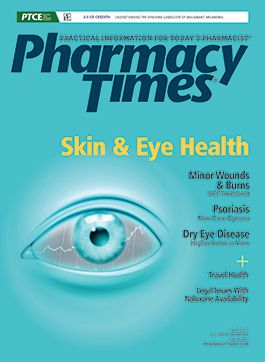Publication
Article
Pharmacy Times
Using Grapefruit to Improve Drug Response
In 1989, researchers doing a study designed to assess a drug interaction between ethanol and felodipine accidentally discovered that grapefruit juice substantially increased felodipine plasma concentrations.
In 1989, researchers doing a study designed to assess a drug interaction between ethanol and felodipine accidentally discovered that grapefruit juice substantially increased felodipine plasma concentrations.1 Since then, grapefruit (as juice or fresh fruit) has been shown to interact with many drugs that are metabolized by CYP3A4. Most of the focus has been on preventing drug toxicity when grapefruit is consumed with CYP3A4 substrates with a narrow therapeutic range. However, 2 recent reports suggest that under certain circumstances, combining grapefruit with drugs may be beneficial.
TACROLIMUS
Seven patients with connective tissue diseases, in whom tacrolimus 3 mg/day did not result in blood concentrations sufficient to reach the target range, started taking about 200 mL of fresh grapefruit juice daily.2 Tacrolimus trough concentrations increased by an average of 3.3-fold after grapefruit juice, and clinical improvement of the connective tissue disease occurred in most patients. Prednisolone requirements also decreased after grapefruit juice, from a mean of 8.1 to 5.9 mg/day.
The results of this study suggest that in patients with connective tissue diseases who fail to respond adequately to tacrolimus, the addition of grapefruit juice may be beneficial. There are several limitations to the study, however. First, only 7 patients were involved, and it was not clear how they were selected given that the researchers had identified 21 patients with inadequate tacrolimus blood concentrations. Second, the type of grapefruit juice was not stated, and the 200-mL daily amount was approximate. Third, there was no mention of the timing of the grapefruit juice consumption and the doses of tacrolimus, or whether the interval between the consumption and the tacrolimus doses was the same for all patients. The results were promising, however, and additional study seems to be warranted.
STATINS
It is well established that grapefruit juice can increase plasma concentrations of lovastatin, simvastatin, and atorvastatin, the statins that are substrates for CYP3A4. Many patients receiving one of these statins are given verbal or written warnings to avoid grapefruit due to an increased risk of rhabdomyolysis. The authors of this review argue that although large amounts of grapefruit can indeed cause dangerously high increases in statin concentrations, normal amounts of grapefruit present a much smaller risk, and may even be beneficial.3
Their argument is 2-fold. First, they argue that the increased lovastatin or simvastatin concentrations from grapefruit would increase the ability of the statin to reduce ischemic heart disease by further reducing LDL cholesterol. Secondly, they argue that combining the statin with a standard amount of grapefruit juice results in a very small risk of rhabdomyolysis. The authors also point out that grapefruit consumed in the morning is likely to have only modest effects on lovastatin or simvastatin taken in the evening.
The argument that grapefruit juice should not be considered contraindicated with lovastatin, simvastatin, and atorvastatin is reasonable. Nonetheless, if no warnings about grapefruit are given to patients on CYP3A4-metabolized statins, some patients may ingest large amounts of grapefruit and may indeed be at risk of rhabdomyolysis. There is also great variability in the magnitude of grapefruit interactions.4 Thus, any consumption of grapefruit by patients on these statins should be coordinated with the prescriber. If the statin response is adequate and an interaction is not desired, the magnitude can be minimized by limiting the amount of grapefruit to 1 glass or 1 fresh grapefruit, and by taking the grapefruit in the morning and the statin in the evening. On the other hand, if there is a desire to increase the statin effect, taking the statin and grapefruit together will increase the magnitude of the interaction. In any case, whenever grapefruit is consumed by a patient on one of these statins, the individual should try to keep relatively consistent the amount and kind of grapefruit, and the interval between the grapefruit and the statin.
END NOTE
Grapefruit can increase the plasma concentrations of many drugs metabolized by CYP3A4. In theory, grapefruit could be used to augment the efficacy of CYP3A4 substrates, and some clinical evidence supports this. Nonetheless, such augmentation should be attempted only with advice and coordination of the prescriber to minimize the risk of adverse outcomes.
Drs. Horn and Hansten are both professors of pharmacy at the University of Washington School of Pharmacy. For an electronic version of this article, including references, visit hanstenandhorn.com.
References
- Bailey DG, Spence JD, Edgar B, Bayliff CD, Arnold JM. Ethanol enhances the hemodynamic effects of felodipine. Clin Invest Med. 1989;12(6):357-362.
- Tsuji H, Ohmura K, Nakashima R, et al. Efficacy and safety of grapefruit juice intake accompanying tacrolimus treatment in connective tissue disease patients. Intern Med. 2016;55:1547-1552.
- Lee JW, Morris JK, Wald NJ. Grapefruit juice and statins. Am J Med. 2016;129(1):26-29. doi: 10.1016/j.amjmed.2015.07.036.
- Bailey DG. Predicting clinical relevance of grapefruit-drug interactions: a complicated process. J Clin Pharm Ther. 2017;42(2):125-127. doi: 10.1111/jcpt.12463.







